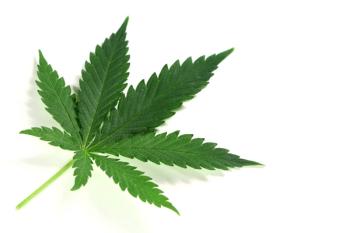
Cannabis Science and Technology
- April 2022
- Volume 5
- Issue 3
- Pages: 31-38
Why All Legalized U.S. Jurisdictions Should (and Probably Will) Adopt the International Intoxicating Cannabis Product Symbol (IICPS)
Working with Doctors for Cannabis Regulation and other stakeholders, David L. Nathan, MD, proposed the Universal Cannabis Product Symbol (UCPS) in 2019. After its publication in 2020, a broad discussion with various stakeholders led to a series of changes to the UCPS. Working with the standards organization ASTM, the authors of this paper co-designed a modified version of the UCPS, which was renamed the International Intoxicating Cannabis Product Symbol (IICPS). This article presents the IICPS and next steps for the industry to start implementing its use.
As individual US states and the federal government approach legalization of cannabis for medical and adult use, a universal symbol for cannabis products is essential to the protection of public health and safety.
Currently, states that have legalized cannabis for medical or adult use have implemented differing requirements for cannabis labeling. These standards vary widely, and in the absence of federal standardization, the solutions that are best for one jurisdiction may not be suitable for another.
Nonetheless, there is one anchor point to ensure that Americans of all ages and backgrounds can correctly identify and exercise caution with cannabis products: a universal symbol on cannabis packages. Such a symbol is critical for, among other reasons, preventing the accidental ingestion of cannabis by adults and children.
However, no cannabis product symbol has met with approval by more than one or two legalized US states, which is a serious issue of public safety now facing regulators, medical professionals, industry stakeholders, patients, consumers, and the general public.
Working with Doctors for Cannabis Regulation and other stakeholders, David L. Nathan, MD, proposed the Universal Cannabis Product Symbol (UCPS) in 2019. After its publication in 2020 (14), a broad discussion with various stakeholders led to a series of changes to the UCPS. Working with the standards organization ASTM, the authors of this paper co-designed a modified version of the UCPS (8), which was renamed the International Intoxicating Cannabis Product Symbol (IICPS) (Figure 1).
At the time of the publication of this article, the IICPS had already been included in the proposed rules for the state of Montana (15), and other newly legalized states are planning to follow suit. Also at the time of this publication, ASTM was actively engaged in an approval process that would make the IICPS the one and only cannabis product symbol to be designated as an internationally recognized consensus standard.
What’s In a Name?
The word “Intoxicating” was added to the name of the symbol to distinguish hemp products from intoxicating cannabis products. The Diagnostic and Statistical Manual of Mental Disorders, Fifth Edition (DSM-5) defines Cannabis Intoxication as meeting all of four criteria (1):
A. Recent use of cannabis.
B. Clinically significant problematic behavioral or psychological changes (for example, impaired motor coordination, euphoria, anxiety, sensation of slowed time, impaired judgment, social withdrawal) that developed during, or shortly after, cannabis use.
C. Two (or more) of the following signs or symptoms developing within 2 hours of cannabis use:
- Conjunctival injection
- Increased appetite
- Dry mouth
- Tachycardia
D. The signs or symptoms are not attributable to another medical condition and are not better explained by another mental disorder, including intoxication with another substance.
In 2021, tetrahydrocannabinol (THC) is the main intoxicating compound in all known varieties of the cannabis plant. Thus, any cannabis products surpassing a defined threshold of THC content should bear the IICPS. Definition of this critical threshold of THC content (typically expressed as a weight in milligrams or as a percentage by weight of the product) is a controversial topic beyond the scope of this paper.
Currently Used Cannabis Product Symbols
Ten US states and the nation of Canada have adopted nine different intoxicating cannabis product symbols. All of them have design problems, generally pertaining to color, shape, symbology, or the prohibited use of text inside a graphical symbol (see Figure 2 and Table I). The International Intoxicating Cannabis Product symbol (IICPS) is an alternative to the many symbols currently in use, but with a fundamental difference: It is firmly rooted in accepted principles of symbology and consensus standards.
Consensus Standards
A truly universal symbol must adhere to existing standards of packaging, labeling, and design. And, in order to be accepted by the US federal government, the symbol should be a consensus standard.
Consensus standards are technical specifications issued by standards development organizations (also called voluntary consensus bodies) such as the American National Standards Institute (ANSI), ASTM, and the International Organization for Standardization (ISO) (2–6,10–13). They are developed in an open environment through collaboration by professionals from both the public and private sectors. This is achieved by cooperation of all parties who have an interest in participating in the creation or use of the standards. Consensus standards incentivize universal compliance beyond recommendations, guidelines, or best practices developed by single individuals, organizations, or particular authorities having jurisdiction (AHJs).
Further, the use of consensus standards is mandated by federal law. The National Technology Transfer and Advancement Act of 1995 (NTTAA) requires the federal government to use privately developed consensus standards whenever possible. The NTTAA codifies what was long considered to be best practice within the federal government.
The NTTAA, Section 1115 of Public Law 107-107, Section 12(d) states (7):
(d) UTILIZATION OF CONSENSUS TECHNICAL STANDARDS BY FEDERAL AGENCIES; REPORTS.—
(1) IN GENERAL.—Except as provided in paragraph (3) of this subsection, all Federal agencies and departments shall use technical standards that are developed or adopted by voluntary consensus standards bodies, using such technical standards as a means to carry out policy objectives or activities determined by the agencies and departments.
(2) CONSULTATION; PARTICIPATION.—In carrying out paragraph (1) of this subsection, Federal agencies and departments shall consult with voluntary, private sector, consensus standards bodies and shall, when such participation is in the public interest and is compatible with agency and departmental missions, authorities, priorities, and budget resources, participate with such bodies in the development of technical standards.
(3) EXCEPTION.—If compliance with paragraph (1) of this subsection is inconsistent with applicable law or otherwise impractical, a Federal agency or department may elect to use technical standards that are not developed or adopted by voluntary consensus standards bodies if the head of each such agency or department transmits to the Office of Management and Budget an explanation of the reasons for using such standards. Each year, beginning with fiscal year 1997, the Office of Management and Budget shall transmit to Congress and its committees a report summarizing all explanations received in the preceding year under this paragraph.
(4) DEFINITION OF TECHNICAL STANDARDS.—As used in this subsection, the term ‘‘technical standards’’ means performance-based or design-specific technical specifications and related management systems practices.
Multiple standards development organizations have approved safety signs and caution symbols that are accepted standards in the US and around the world, and those consensus standards may be readily applied to a universal cannabis product symbol.
Safety Signs
The international consensus standard for safety symbols is ISO 3864 (10–12), which corresponds to the similar US consensus standard ANSI Z535.4: Product Safety Signs and Labels (3).
ISO 3864 standardizes five safety signs as shown in Table II.
For a cannabis product symbol to be compliant with consensus standards, then one of these safety signs must be chosen. Thus, a symbol indicating prohibition, mandatory action, safe condition, or fire equipment would be inappropriate. The only logical option is the standard warning sign, which consists of a black graphical symbol inside a black-bordered yellow equilateral triangle with radiused outer corners.
Letters, numbers, punctuation marks, and mathematical symbols may not be included in standard graphical symbols, with the sole exception of an exclamation point as the graphical symbol in two signs: the General Mandatory Action Sign (ISO 7010-M001) and the General Warning SIgn (ISO 7010-W001) (13). Not one of the hundreds of other registered safety signs in ISO 7010 includes an exclamation point or any other letter, number, or punctuation mark. This strict standard ensures comprehensibility of graphical safety signs by anyone, regardless of age, literacy, and language differences.
People may not recognize “THC” as identifying a cannabis product if they are young, illiterate, do not use the Latin alphabet, or lack specific education about cannabis. Thus, the use of “THC” inside a cannabis product symbol is not just prohibited by consensus standards—it’s also discriminatory.
Creation of the International Intoxicating Cannabis Product Symbol
The International Intoxicating Cannabis Product Symbol (IICPS), intended to symbolize “caution with cannabis,” was the product of a collaboration between cannabis policy experts and designers, utilizing existing standards. This effort is part of a larger project for standardized cannabis labeling initiated by Doctors for Cannabis Regulation (9).
When setting out to design the IICPS, the creators stipulated that it must satisfy a strict set of criteria:
- Adhere to existing precedents of standard symbols, so the public will immediately understand the meaning of the symbol.
- Use symbology that transcends age, literacy, knowledge of the Latin alphabet, specialized knowledge about cannabis, language, and culture.
- Allow for the addition of optional text to meet the needs of authorities having jurisdiction in the US and around the world.
This is not a stop-gap solution until some other design is developed. This is the solution—a symbol designed for permanent use by individual states, the federal government, and other nations.
IICPS Symbology
ISO 3864-2 (11) requires that the standard warning sign include a black graphical symbol within the yellow triangle. ISO 3864-3 (12) specifies that the graphical symbol inside a warning symbol should:
- Utilize objects, concepts, and activities, or a combination of these, which are familiar to the target group
- Contain only those details that contribute to understanding
- Be readily associated with its intended meaning
- Be easily distinguishable from other graphical symbols
For cannabis products, the only symbol that satisfies these criteria is a cannabis leaf. It is far and away the most familiar graphical symbol associated with cannabis. A joint, bong, or other paraphernalia, for example, would limit the scope of the symbol and require the consumer to make a logical jump from cannabis to paraphernalia that may be unfamiliar to many. An exclamation point cannot be included in the design, as alphanumeric characters and punctuation marks are forbidden in all consensus standard symbols, except for the generic warning sign with an exclamation point. Also, an exclamation point does not add to recognition of the symbol and would require that the cannabis leaf inside a warning triangle be reduced to an undesirably small size (see California’s cannabis product symbol in Figure 2).
The IICPS creators thus concluded that the cannabis leaf is the only suitable symbol to be placed within the warning triangle (Figure 3).
The size and shape of the leaf were carefully chosen to include several desirable characteristics:
- The leaf has a distinct shape and serrated margins to distinguish it from the leaves of other plant species, thus reinforcing the public’s accurate identification of cannabis plants.
- The leaf has well-separated leaflets that remain clear at small sizes, as when printed on vape cartridges or embossed on edible servings.
- The leaflets have a silhouette and leaflet count that is intermediate between those of typical mature leaves of the two main varieties of the cannabis plant (Cannabis sativa L.): “indica” and “sativa.”
Putting together the standard warning sign and the cannabis leaf, the International Intoxicating Cannabis Product Symbol was born (Figure 4). The design of the IICPS is fully compliant with ISO 3864 and ANSI Z535 (Figure 5).
Supplemental Text Options
Consistent with ISO 3864, the IICPS is designed to permit the use of text below the symbol, so alphanumeric or special characters may be placed under the symbol for supplemental information (Figure 6). This allows for uniformity in the symbol while meeting the varying needs of authorities having jurisdiction in the US and around the world. It also obviates any purported need for the inclusion of letters, numbers, or special characters inside the symbol itself.
Black and White Option
A black and white version of the IICPS falls outside ISO and ANSI standards for warning signs, which mandate the use of “warning sign yellow” (Pantone 109) as a background color. Thus, it should be used only if color printing is impossible and black and white printing of the IICPS is permitted by the authority having jurisdiction (Figure 7).
Ready for Use Now
We present the IICPS to regulators with a simple message: This is not just the right choice as a universal symbol for cannabis products—it’s also the safe choice.
The IICPS is the only cannabis product symbol in the world that is on track to become a consensus standard (6). It is undergoing approval through the international standards development organization ASTM. The IICPS was unanimously approved by the working group developing a symbol for ASTM’s Committee D37 on Cannabis. The final step is the pending approval of ASTM WK75247—Specification for an International Symbol for Identifying Consumer Products Containing Intoxicating Cannabinoids by the full committee membership of more than 1000 stakeholders.
Typically, once one major standards development organization publishes a consensus standard, the others will support it unless there is a compelling reason to reject it. Regardless, the designers of the IICPS believe that if another standards development organization set out to create a universal symbol for cannabis products, existing precedents for warning signs and the ubiquity of the cannabis leaf as a representative graphical symbol would guide another organization to choose a design that is fundamentally indistinguishable from the IICPS.
When this symbol becomes the ASTM consensus standard, and cannabis is regulated at the national level, US federal regulators will likely be obligated to use the IICPS under the National Technology Transfer and Advancement Act of 1995 (NTTAA).
Organizational Support for the IICPS
The authors invite cannabis stakeholders to support the IICPS by formally endorsing its use by states, the federal government, and other authorities having jurisdiction. Please contact
Next Steps for Regulators
To facilitate immediate adoption by regulators, the designers have published the symbol in multiple digital file formats (for example, PDF, EPS, SVG, and JPG) for distribution and use. The symbol will be available for use by regulators worldwide: on demand, in perpetuity, royalty-free, and at no cost.
Regulators may address any questions or requests for IICPS digital files to
Acknowledgments
The authors wish to thank the following individuals for their contributions to the development of the IICPS and/or the preparation of this manuscript: Bryon Adinoff, MD, President, Doctors for Cannabis Regulation; Martha Bajec, Consulting Director, Health & Wellness Research; David Gorelick, MD, PhD, DLFAPA, FASAM, Professor of Psychiatry, University of Maryland School of Medicine; Audra Horridge, VP of Product, Advanced Vapor Devices; Mauricio Mejia, Environmental Administrator, Division of Consumer Services, Florida Department of Agriculture and Consumer Services; Darwin Millard, Chief Science Officer, Canada, Final Bell; Robert J. Morgan, Director, Technical Committee Operations, ASTM International; Karen K. Nathan, EdM; Michelle Niedziela, PhD, VP of Research & Innovation, HCD Research; Jon D. Robinson; Phil Simoes, Principal, Design & Consulting, PS Consulting Services; Christopher Smith, Partner, BGP Advisors; and Leslie Mendoza Temple, Clinical Associate Professor, Family Medicine, University of Chicago Pritzker School of Medicine.
References
(1) American Psychiatric Association. Diagnostic and Statistical Manual of Mental Disorders (5th ed.) (American Psychiatric Publishing Co.: Washington, DC, 2013).
(2) ANSI Z535.1-2017, American National Standard for Safety Colors. American National Standards Institute, Inc. (Secretariat: National Electrical Manufacturers Association): Approved October 20, 2017.
(3) ANSI Z535.4-2011, Product safety signs and labels. American National Standards Institute, Inc. (Secretariat: National Electrical Manufacturers Association): Approved July 19, 2011.
(4) ASTM D8233-19, Standard Guide for Packaging and Labeling of Consumer Resin Cannabis Products for Sale to Adult Consumers, Legally Authorized Medical Users, and Caregivers in a Business-to-Consumer Retail Environment (Retailers). ASTM: 2019.
(5) ASTM D8270-19, Standard Terminology Relating to Cannabis. ASTM: 2019.
(6) ASTM WK75247, Specification for an International Symbol for Identifying Consumer Products Containing Intoxicating Cannabinoids. ASTM: Pending approval, which is expected in early 2022.
(7)
(8) K.B. Connelly, “Is a ‘Cannabis Facts Label’ in Our Future?” Packaging Digest, April 28, 2021. (Note: This article features a later version of the UCPS, which was modified slightly and renamed the IICPS.)
(9) Doctors for Cannabis Regulation. “Universal Cannabis Symbol.” DFCR website. Accessed November 1, 2021.
(10) ISO 3864-1:2011, Graphical symbols—Safety colours and safety signs—Design principles for safety signs and safety markings. International Organization for Standardization: Second edition, 2011-04-15.
(11) ISO 3864-2:2016, Graphical symbols—Safety colours and safety signs—Design principles for product safety labels. International Organization for Standardization: Second edition, 2016-12-15.
(12) ISO 3864-3:2012(en), Graphical symbols—Safety colours and safety signs—Design principles for graphical symbols for use in safety signs. International Organization for Standardization: Second edition, 2012-02-01; Corrected version 2012-06-15.
(13) ISO 7010:2019, Graphical symbols—Safety colours and safety signs—Registered Safety Signs. International Organization for Standardization: Third edition, 2019-07; Corrected version 2020-06.
(14) D.L. Nathan, “Setting the Standard for Cannabis Labeling: Introducing the Universal Cannabis Product Symbol and Universal Cannabis Information Label.” Cannabis Science and Technology3(6) 44-52 (2020). (Note: This article introduces the original UCPS, which was later modified and renamed the IICPS.)
(15) State of Montana. “Notice of Public Hearing on Proposed Adoption and Amendment - Implementation of the Montana Marijuana Regulation and Taxation Act.” Montana Administrative Register Notice 42-1033. No. 20, October 22, 2021.
About the Authors
The authors are co-designers of the International Intoxicating Cannabis Product Symbol. David L. Nathan, MD, DFAPA,is the founder and past president of Doctors for Cannabis Regulation and a clinical associate professor at Rutgers Robert Wood Johnson Medical School. Eli Nathan is a product designer and a student at the University of Pennsylvania. Direct correspondence to:
Articles in this issue
over 3 years ago
Beer’s Law, Part II: Physical Basis and Derivationover 3 years ago
What’s in a Vape, Part Iover 3 years ago
How Poor Environmental Control Creates Pest Pressurealmost 4 years ago
Cannabis Science Conference Honors the Wisdom of WomenNewsletter
Unlock the latest breakthroughs in cannabis science—subscribe now to get expert insights, research, and industry updates delivered to your inbox.




